How I Raise My Dexter Calves
— and Why It Works for Me
by Michelle Parsley, M.Photog., M.Artist, Cr.
Every calf born at Mountain Heritage Farm is raised with purpose
— but not every calf nurses its own dam.
Raising calves is one of my favorite parts of farm life. Each one is a clean slate — curious, stubborn, and full of personality — and the way they’re raised shapes the kind of cow they’ll become. Over the years, I’ve developed a system that balances animal health, milk safety, and practicality for a small raw-milk dairy.
It’s not a “one size fits all” approach. Heifers, bulls, and steers each have different purposes — and their early handling reflects that. However, my universal goal is always the same: calm, healthy calves that grow into calm, healthy cows.
📷 Miss Carly with her newborn heifer, Cassidy.

The Foundation: Real Milk and Real Mothering
Every calf here is raised on milk suited to its purpose — and for most, that means whole, raw milk straight from our Dexter cows.
My heifer and bull calves always receive real milk from the herd. That start provides the enzymes, antibodies, and balanced nutrition nature intended, giving them the best foundation for long-term health and performance.
Whenever possible, heifer calves are raised by either their own dam or a nurse cow rather than on a bottle. It’s not always feasible — sometimes a cow doesn’t calve cleanly, or the timing isn’t right — but it’s always the goal. Calves raised by cows develop a natural sense of herd rhythm and boundaries from day one, while bottle-raised heifers tend to be friendlier and more people-focused. Both approaches have their strengths, but for future milk cows, I prefer that early cow-to-cow interaction whenever circumstances allow. There's always time to build the human bond as the calves grow.
Bull prospects, however, are dam-raised 100 percent of the time. That’s non-negotiable. A bull raised by a cow learns boundaries early — lessons that translate into lifelong respect for both cows and people. Bulls raised on the bottle, on the other hand, bond to humans instead of their herd and often lose that natural sense of respect. Inexperienced or overly friendly bulls can become unpredictable — and in some cases, deadly.
My steers are typically raised on a high-quality milk replacer. It’s a practical choice that keeps the system sustainable. If I have enough nurse cows, I’ll put a steer on one — but that rarely happens. The nurse cows stay focused on raising the heifers that will remain in the herd, while the steers grow evenly and predictably on a managed bottle routine.
It’s not about preference — it’s about purpose. Every feeding decision here is made intentionally, based on what sets each calf up for success within the herd.
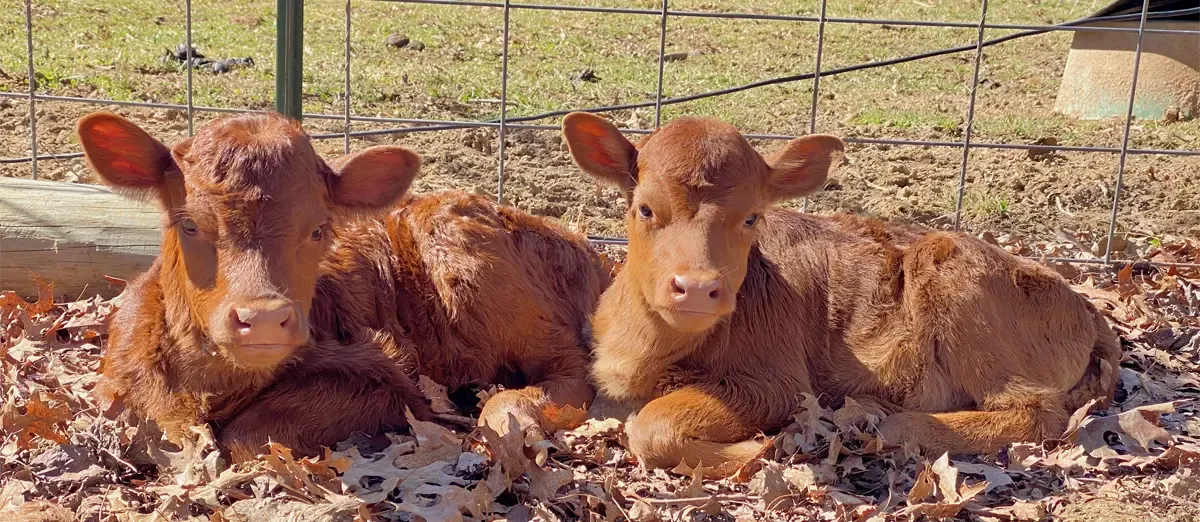
Over time, this approach has given me a balance of good animal handling, milk safety, and consistency — all without the added stress or sanitation challenges that come with calf sharing. Every cow knows her job: the milk cows milk, and the nurse cows mother. That clarity keeps our system clean, calm, and predictable.
If you’re wondering why I don’t practice calf sharing, I explain my reasoning in detail here:
Why I Don't Calf ShareHeifers: Learning to Be Cows
Heifer calves are the future of every dairy herd, so I invest the most time and care in how they’re raised. A good milk cow starts long before she ever steps into the parlor — it starts with structure, calm handling, and management that respects both the calf and her dam.
Weaning and Cow Condition
Bottle or bucket-raised heifers are usually weaned between 100 and 120 days, while those raised on a nurse cow or their dam stay on milk until 4–5 months of age. I watch the dam closely — once I see body condition slipping, especially in older cows, it’s time to wean. Keeping a heavy milker nursing past five months is hard on both her and her udder, and I want them heading into winter in good condition.
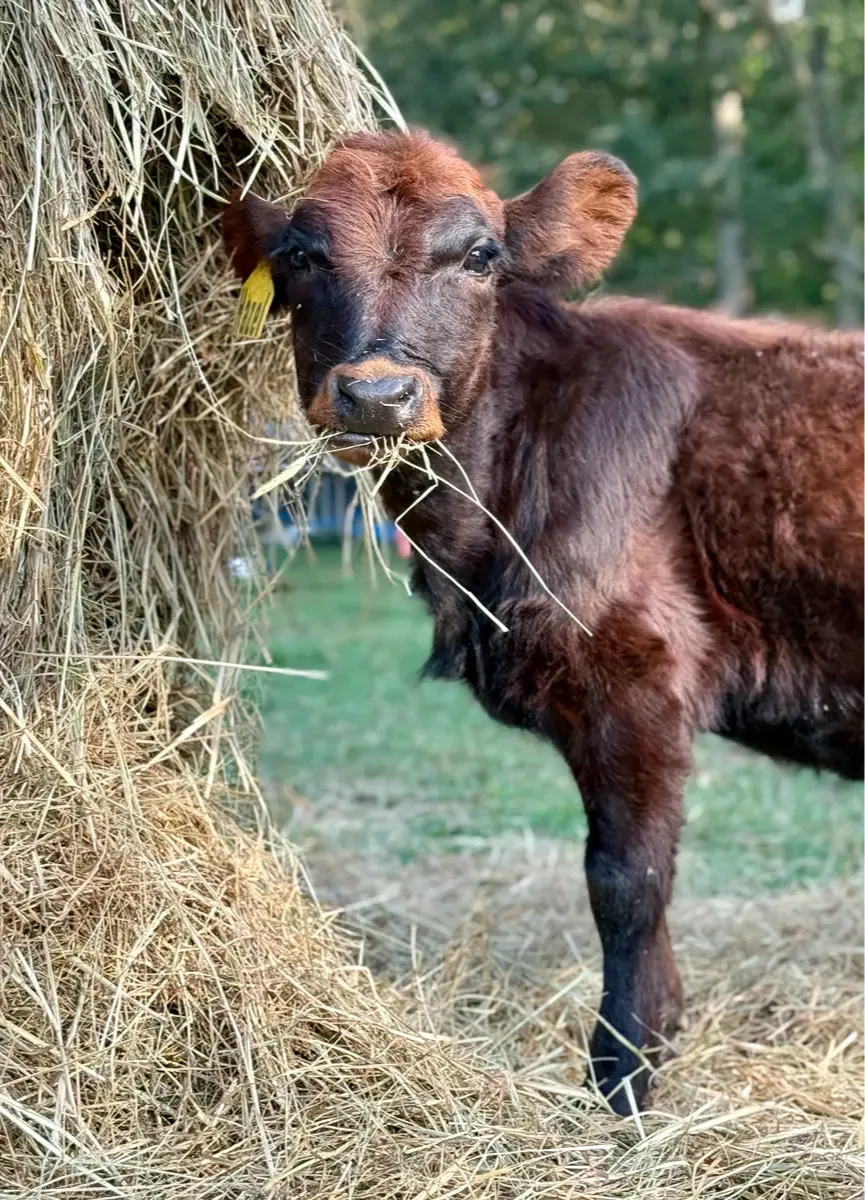
Handling and “Survival Halter Training”
Every heifer gets what I call survival halter training — meaning she will walk on a halter, but she’s not “show broke.” The goal isn’t polish; it’s safety and manageability when a halter is needed for health checks, breeding evaluations, or transport.
From birth, I also make a point to handle each heifer’s udder area frequently. By the time she’s grown, that kind of touch isn’t a surprise — it’s normal. This early desensitization pays off later; my first-fresheners stand quietly for milking because they’ve been handled that way all their lives.
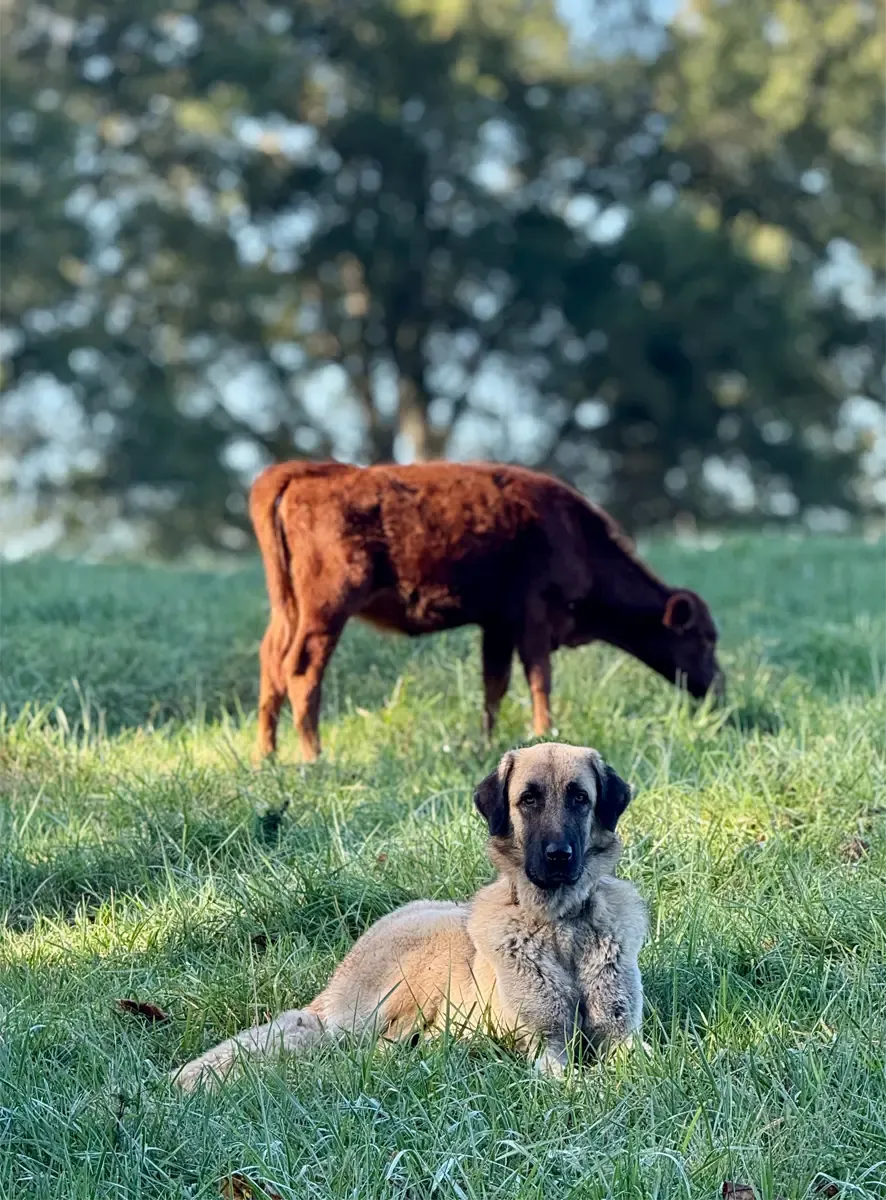
Housing and Safety
Bucket and bottle calves are raised in a dedicated pasture with two Anatolian guardian dogs for protection. They learn to graze, interact with other calves, and build confidence while still being easy to handle. Once weaned, all heifers move to a separate pasture we affectionately call “Girl Scout Camp.” They stay there for at least a year, well away from wet cows, because even older weanlings will try to nurse again if given the chance.
Temperament and Training
I’ve never had a heifer born here with a temperament issue serious enough to keep her off the milk string. Calm handling, good genetics, and routine go a long way toward shaping cows that are steady in the parlor and pleasant to work with.
That said, I’ve learned that temperament isn’t something you can always fix. I did own one heifer — not born here — who never settled. We called her New Day because every morning it was as if she’d never seen a human before. After six months of patient, daily effort, I made the decision to sell her to a beef focused farm. A dairy cow must be steady and trustworthy; anything less is unfair to both cow and milker.
After calving, here’s exactly how I train a Dexter heifer to milk:
How to Train a Dexter HeiferBulls: Respect Starts in the Maternity Pen
Bull calves are managed differently from the start, because their behavior as adults depends heavily on how they’re raised. Every bull prospect here is dam-raised 100 percent of the time — no exceptions.
A bull raised by his dam learns boundaries early. She corrects pushy behavior, enforces personal space, and teaches him where he fits within the herd. That foundation produces bulls that are confident, not spoiled — and respectful of both cows and people.
Bottle-raised bulls, on the other hand, bond to humans instead of cattle. Without a cow to discipline them, they grow up viewing people as part of their herd hierarchy — and they’ll test you just as they would another bull. What starts as a nudge or playful head toss can escalate quickly. Bulls raised on the bottle can — and have — been deadly.

Evaluation and Steering
I begin evaluating bull calves around four weeks of age, after they’ve had time to “unfold” from birth. Conformation comes first — I use the same standards outlined in my Choosing a Bulluide. If a calf shows structural flaws, weak feet, or an uneven topline, he’s steered.
A dam’s record weighs heavily in the decision. If she’s slow to milk, lacks udder quality, or has structural problems, her bull calf won’t stay intact no matter how correct he looks. I’m not just raising individuals — I’m building a breeding program — and that means only the best genetics move forward.
Temperament is the final filter. Bulls should have a calm, “Eeyore” disposition — alert but steady. Anything high-headed or reactive is steered immediately.
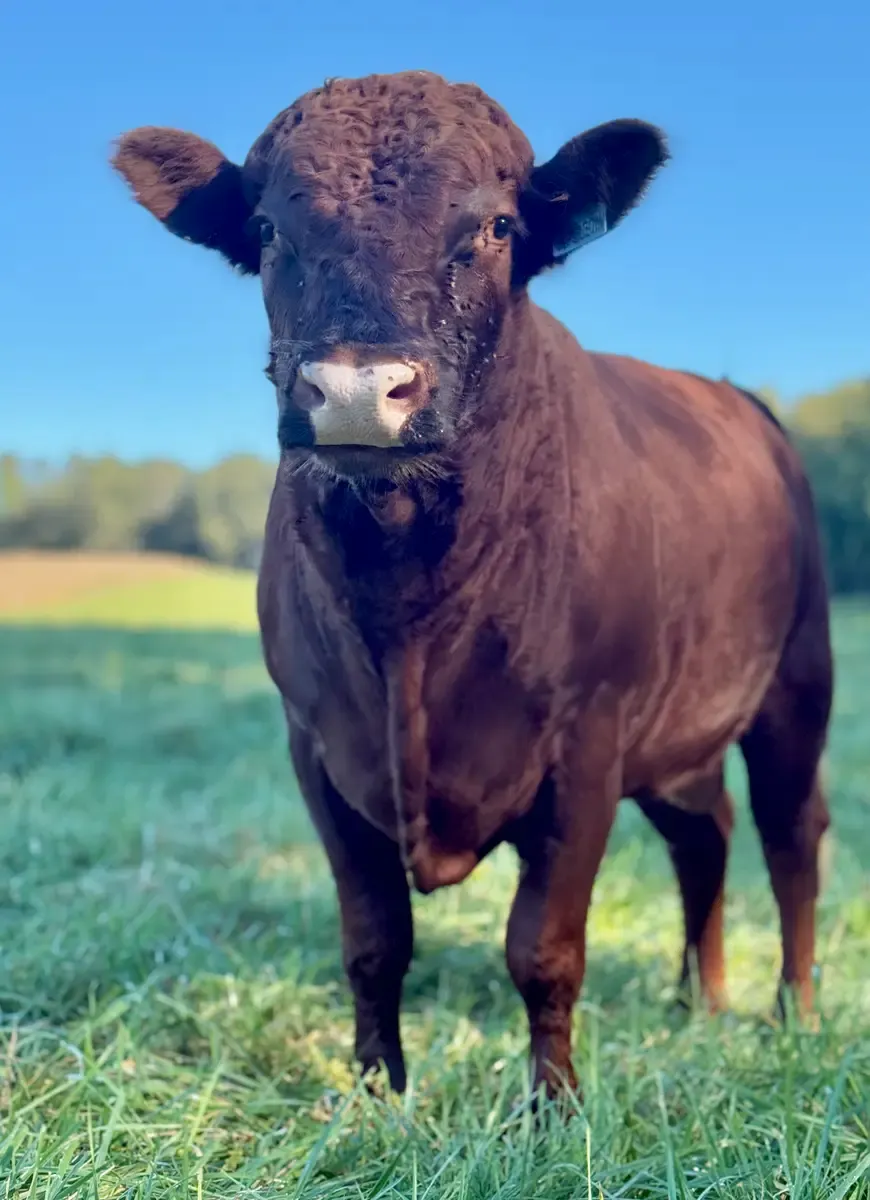
Handling and Safety
Until about eight months of age, bull calves are handled just like heifers — calm, consistent, and respectful. Once they approach puberty, I begin reinforcing distance. I expect them to move away when I enter a space, not approach. It’s not fear — it’s respect, and that distinction keeps everyone safe.
As they mature, bulls are always managed with clear boundaries and physical separation when necessary. No hand-feeding, no scratching foreheads (although I do offer neck scratches from time to time), and no exceptions on behavioral expectations.
A calm, safe bull is a product of early discipline and consistent management — not familiarity.
Steers: Healthy, Hands-On, and Practical
Steers serve a different purpose here, so their management reflects that. While heifers and bulls are raised with future breeding or milking in mind, steers are grown for beef — which means their needs are simpler, but no less important.
Most steer calves are raised on a high-quality milk replacer. If I have extra nurse cows available, I’ll put a steer on one, but more often they’re fed by bottle or bucket. It’s a system that keeps the herd balanced — the nurse cows focus on raising the heifers that will stay in the program, and the steers still grow evenly on a consistent feeding schedule.
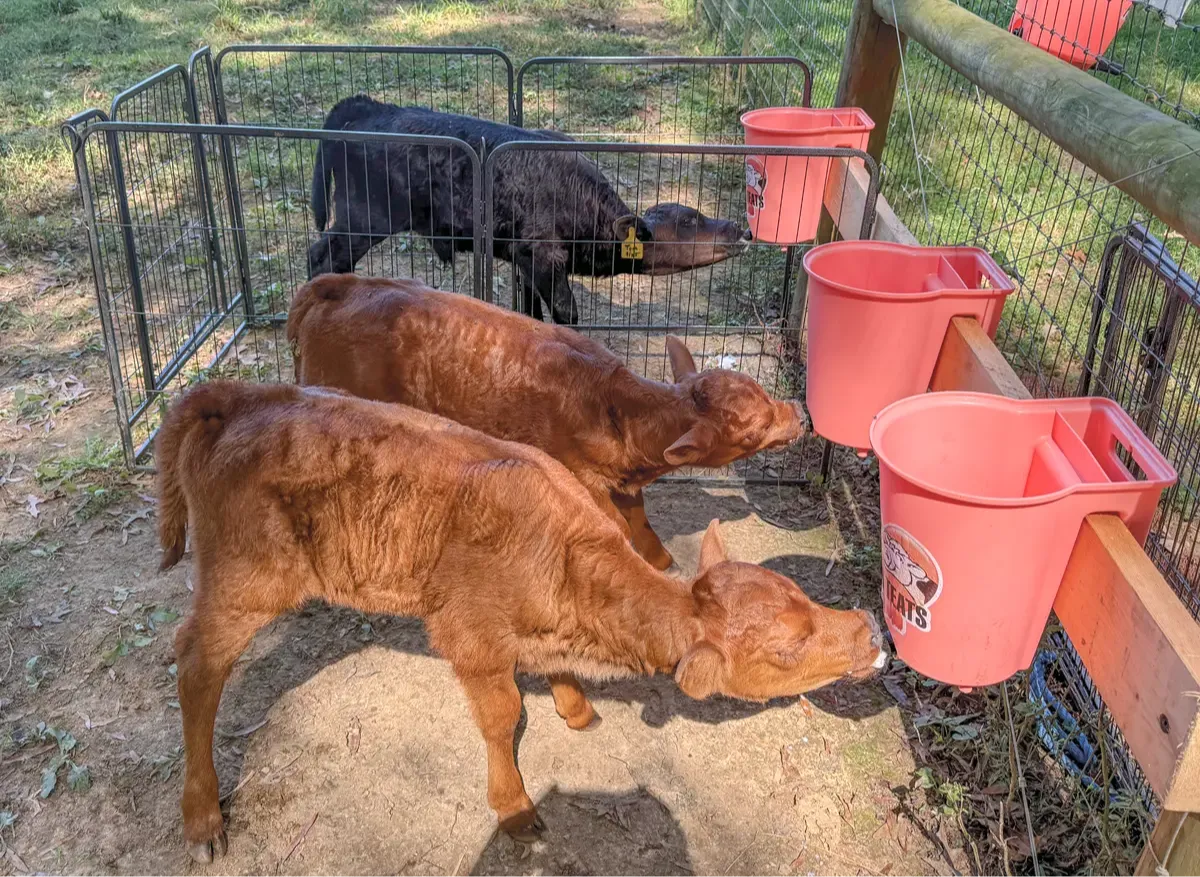
Feeding and Growth
Steers start on warm replacer, fed from a low-mounted bucket to mimic natural nursing posture. They’re weaned at roughly 100–120 days, depending on growth and appetite. I track weight gain closely and make sure they transition smoothly to hay and grain. Consistent intake is key — big swings in feeding amount or timing can create digestive stress.
Housing and Handling
Steers are raised with other bottle or bucket calves in the same protected pasture where the Anatolians stand guard. They’re handled calmly and frequently so they stay easy to move, load, or doctor when necessary.
Practical Outcomes
This approach keeps things simple, sustainable, and predictable. Every calf is well-fed, socialized, and managed according to its role in the herd. The steers grow into quiet, well-finished animals without taking resources from the breeding program. It’s a system that respects both the animal and the purpose it serves.
Frequently Asked Questions
“Isn’t bottle feeding more work?”
“Won’t the calf miss its mom?”
“Isn’t calf sharing more natural?”
How to Bottle Feed a Dexter Calf Safely
Bottle feeding looks simple, but it’s one of the easiest places to make costly mistakes. The angle of the neck, the height of the bucket, and even the flow rate of the nipple can determine whether a calf thrives or develops serious respiratory issues.
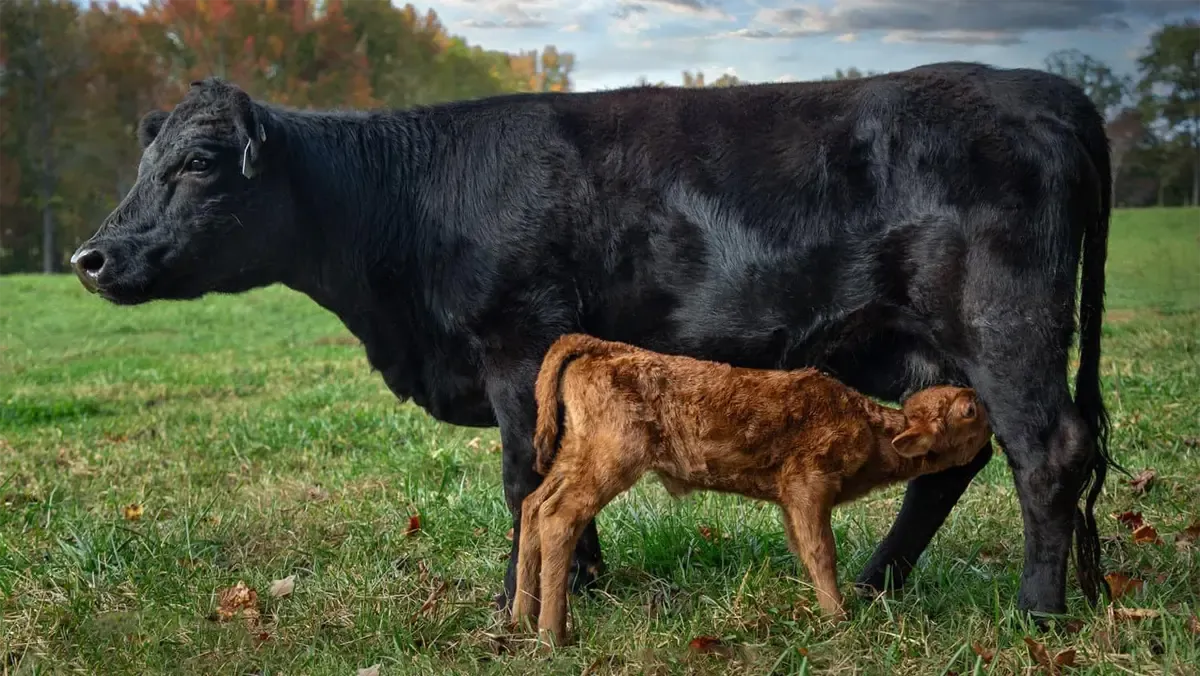
Why Position Matters
When a calf nurses from its dam, the udder hangs low. The calf stretches its neck forward and down, triggering the esophageal groove reflex — a flap that closes off the rumen and directs milk straight into the abomasum (the “true” stomach).

Position Your Bucket Carefully
If a bottle or bucket is positioned too high — even chest height — milk can enter the wrong compartment or, worse, the lungs. That’s how aspiration pneumonia happens. It’s one of the most common and preventable causes of poor growth and death in bottle-fed calves.
Bottles with Calf Nipples
-
Easiest and safest choice for newborns.
-
Hand hold to mimic the udder’s natural position and flow.
-
Allows full control over intake, pace, and height.
Buckets
-
Best once calves are confident and strong.
-
Must be placed low — around knee height.
-
The calf should stretch forward and down, never up.
-
Use slow-flow nipples to prevent gulping and choking.
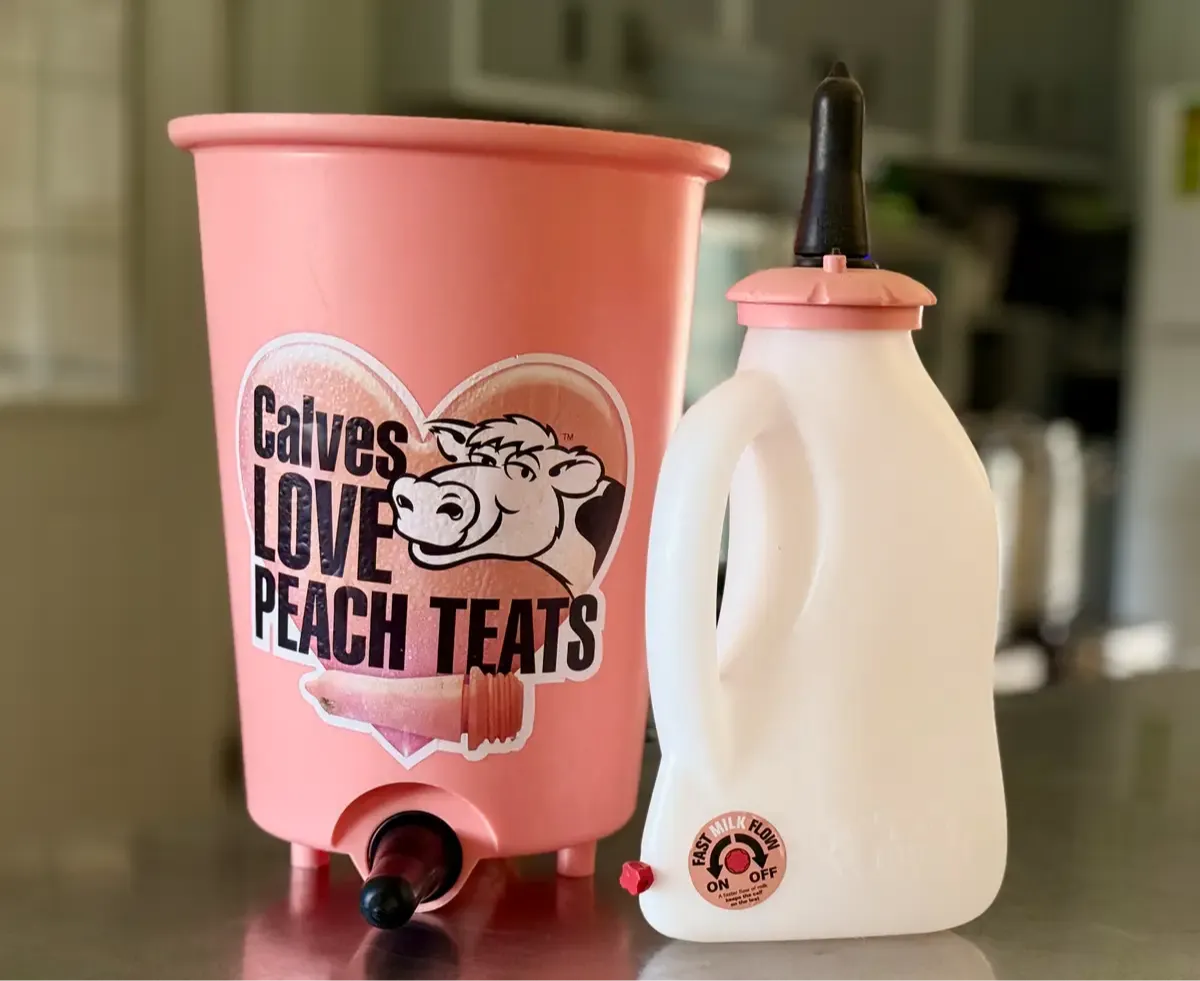
I am a huge fan of Peach Teat brand bottles and buckets.
They work beautifully for my Dexter calves!
🍼 Daily Milk Requirements for Dexter Calves
(Based on ≈ 1 gallon per 50 lb body weight per day, divided into 3 feedings)
One of the most common questions I’m asked is, “How much do I feed my bottle calf?”
A healthy Dexter calf needs roughly 1 gallon of milk per 50 pounds of body weight every 24 hours, divided into three feedings — morning, mid-day, and evening. For quick math, use this simple rule of thumb: 1 ounce of milk per 10 pounds of body weight per hour.
Steady intake supports rumen development, growth, and immune strength — especially important for Dexters, which grow more slowly than commercial dairy breeds.
Raw Milk vs. Milk Replacer
If you’re feeding whole raw milk, you can be a little more generous. It’s difficult to overfeed when milk is fresh, warm, and biologically active. Raw milk contains natural enzymes and fats that help the calf self-regulate intake and digest what it consumes.
Milk replacer, however, is a different story. Because replacer lacks those live enzymes and spoils quickly once mixed, you must stick very closely to the feeding guidelines in both quantity and timing. Overfeeding replacer — or feeding it too cold, too fast, or too concentrated — can cause scours, the cattle term for diarrhea. Scours dehydrate calves quickly and, if not corrected, can be fatal within hours.
Tracking Growth and Adjusting Quantities
Below is a simple weight-to-milk chart to use as a reference for Dexter calves of varying sizes.
I weigh my calves at birth by standing on a bathroom scale while holding the calf, then subtracting my weight. You can keep using that method to monitor growth and make sure your calf is gaining appropriately. Over time, you’ll learn to judge by eye when it’s time to increase the milk ration.
In practice, I rarely exceed 1.5 gallons of milk per day, regardless of weight, because I want calves to begin eating grain and grass as they would if dam or nurse cow raised.
Once they’re about 45 days old, eating, and growing well, I reduce to two feedings per day — morning and evening — to encourage rumen development and independence. I’m usually at 1.5 gallons per day when I make that transition.
| Calf Weight (lb) | Daily Milk (gal) | Daily Milk (liters) | Per Feeding (3×/day) | Approx. oz/feeding |
|---|---|---|---|---|
| 35 | 0.7 | 2.6 | 0.23 (0.9 L) | 30 |
| 40 | 0.8 | 3.0 | 0.27 (1.0 L) | 34 |
| 45 | 0.9 | 3.4 | 0.30 (1.1 L) | 38 |
| 50 | 1.0 | 3.8 | 0.33 (1.25 L) | 43 |
| 55 | 1.1 | 4.2 | 0.37 (1.4 L) | 47 |
| 60 | 1.2 | 4.5 | 0.40 (1.5 L) | 51 |
| 65 | 1.3 | 4.9 | 0.43 (1.6 L) | 55 |
| 70 | 1.4 | 5.3 | 0.47 (1.8 L) | 60 |
| 75 | 1.5 | 5.7 | 0.50 (1.9 L) | 64 |
| 80 | 1.6 | 6.1 | 0.53 (2.0 L) | 68 |
| 85 | 1.7 | 6.4 | 0.57 (2.1 L) | 72 |
| 90 | 1.8 | 6.8 | 0.60 (2.3 L) | 77 |
| 95 | 1.9 | 7.2 | 0.63 (2.4 L) | 81 |
| 100 | 2.0 | 7.6 | 0.67 (2.5 L) | 85 |
Sanitation and Cleanliness
Clean equipment is just as important as proper feeding volume. Bacteria multiply rapidly in leftover milk residue, especially in warm weather. I wash all bottles, nipples, and buckets in a commercial high-temperature dishwasher every day — especially if I’m feeding replacer. If you don’t have access to high-temp sanitation, use very hot water, rinse immediately after each feeding, and air-dry upside down so moisture can escape.
Meticulous sanitation prevents digestive upsets, protects gut health, and ensures calves stay bright-eyed and hungry — the best indicators of good digestion.
Always Remember:
Bottle feeding is more than just giving milk — it’s about replicating the natural nursing posture and quantity of milk so the calf’s body works as designed. Get it right, and you’ll raise healthy, thriving calves. Get it wrong, and you’ll battle pneumonia, scours, or worse.
That’s why I never compromise on feeding position, temperature, or sanitation. The details matter — and the calves are worth it.
📷 Newborn calf just after his first bottle.
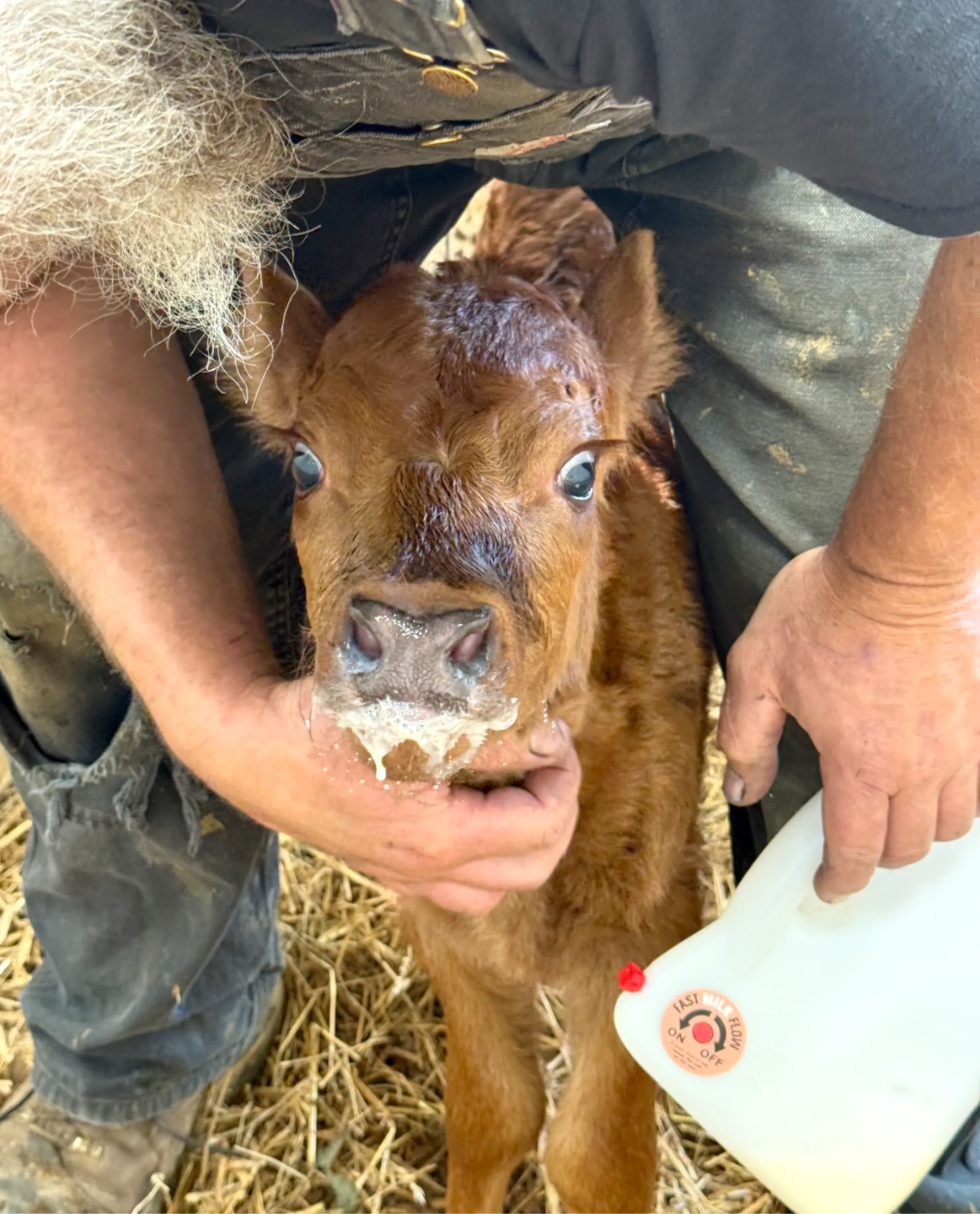
Nurse Cows: The Middle Ground
Nurse cows are the quiet workhorses of my system — the bridge between full dam-raising and bottle feeding. They allow me to give multiple calves the benefits of real milk and cow contact, while still maintaining milk quality and consistency in the parlor.
A nurse cow is a steady, gentle cow who willingly accepts calves that aren’t her own. She’s the one who helps me raise heifers whose dams are being milked. Because she happily nurses two or three calves at a time, I can be sure those calves get the nutrition, antibodies, and social learning that come from being raised by a cow — not a person.
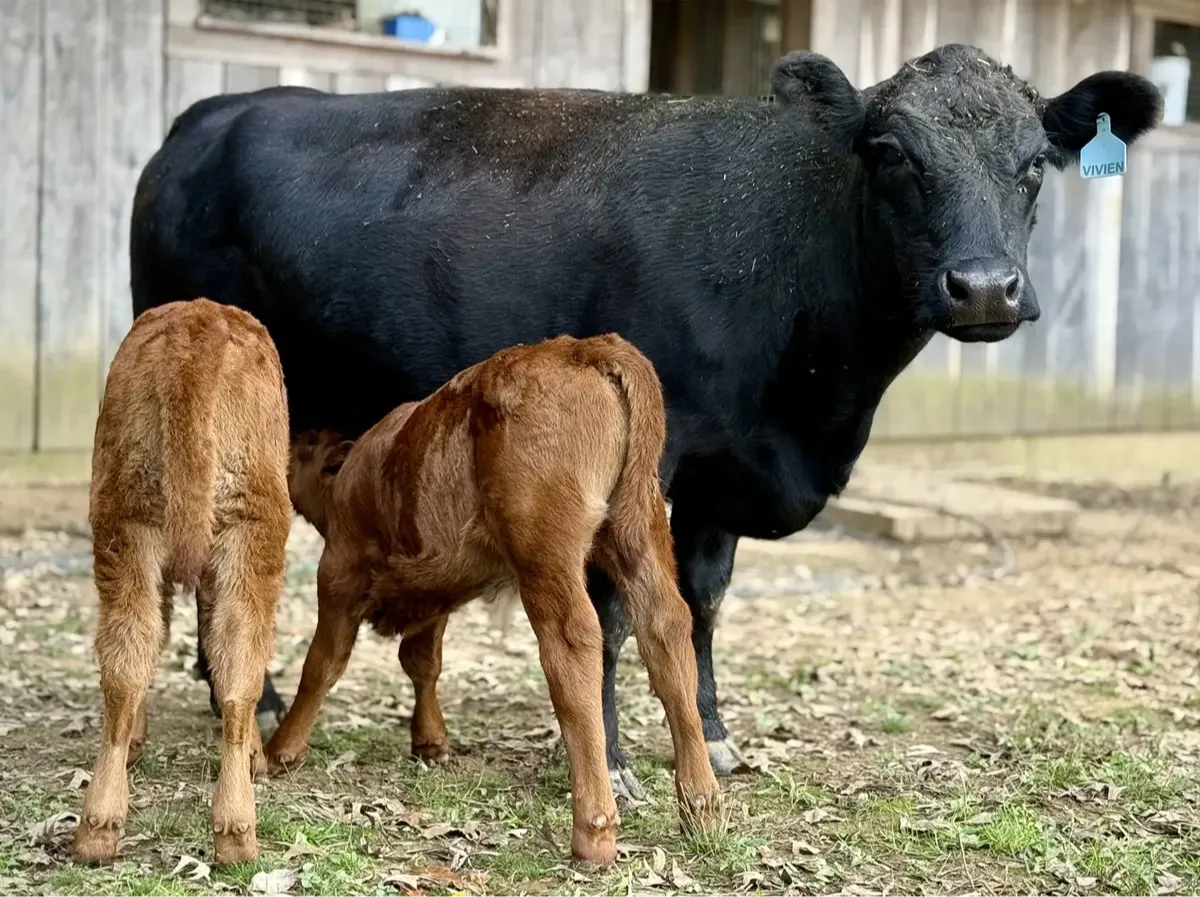
Not Every Cow Can Do It
It’s important to understand that not every cow will nurse another calf. The willingness to take on extra babies varies widely by temperament and maternal instinct. Some cows welcome any calf that approaches; others flatly refuse. For that reason, I select nurse cows carefully for their calm, tolerant nature.
When I assign new calves, I pen the cow and the calves together in a small, secure area for about two weeks. That close confinement helps everyone learn the routine, and it ensures the cow is truly feeding and protecting all of the calves — not just her own.
I also monitor the condition of the calves closely during this period. If I see one looking “hollow” on its sides, that’s often a sign the cow’s milk supply isn’t quite keeping up. In that case, I’ll offer a supplemental bottle here and there for a few days while her production catches up. It’s a careful balancing act, though — too many bottles and the calves won’t nurse enough to stimulate her milk supply to increase.
Energy level is another reliable indicator. Healthy, well-fed calves are bright, active, and alert. If a calf starts to seem dull or lethargic, it’s time to reevaluate whether everyone is getting their fair share.
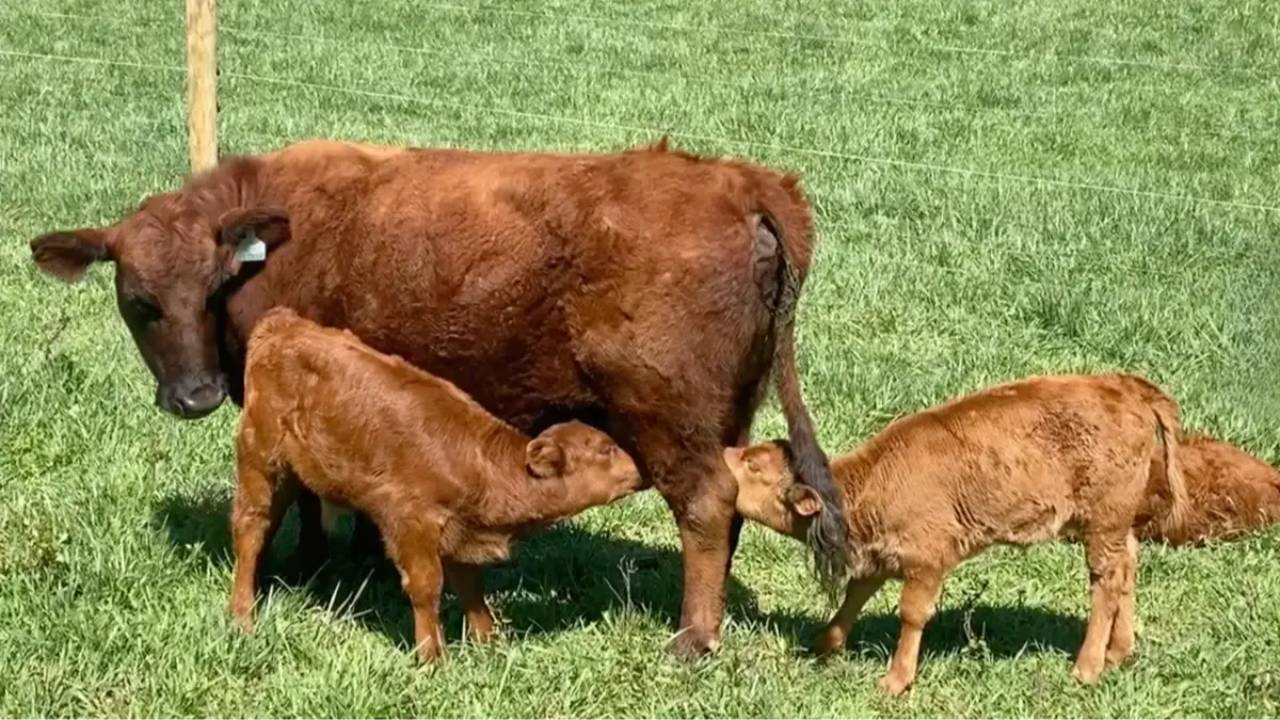
Matching Calves by Age and Size
Calves placed on a nurse cow should be close in age and size. A four-month-old can strip the udder before a newborn even gets started, leaving the smaller calf short on milk. Keeping ages similar prevents competition and ensures steady growth for every calf in the group.
🎥 In the video below, Luna is nursing 3 calves simultaneously -- none of the calves are hers.
Health and Milk Quality
Using nurse cows also helps keep my bottling milk clean. Calves on nurse cows never contact the cows whose milk is sold for human consumption, which eliminates cross-contamination and keeps bacterial counts low. It’s one of the key reasons my system remains both traditional and food-safe.
Practical Balance
Nurse cows give me the best of both worlds: cow-raised calves with healthy social skills and a milking herd that stays focused on production. It’s a calm, contained system — no confusion at milking, no guessing which side a calf emptied, and no compromise on milk quality.
The Goal Is Always the Same
However they start — bottle, nurse, or dam — my goal is always the same: calm calves that grow into calm cows. The methods may vary, but the principles don’t. Every feeding, every boundary, and every routine is designed to build trust, predictability, and respect between human and animal.
Raising Dexter calves isn’t just about nutrition or convenience — it’s about shaping temperament, health, and confidence for years to come. A well-raised calf grows into a cow that’s steady in the parlor, gentle on the halter, and easy to handle through every season of her life.
Each calf teaches me something new. Some remind me to be patient, some challenge what I thought I knew, and all of them help refine the system that keeps this farm running smoothly. Over time, those quiet lessons add up to what I value most: a calm, consistent herd where every animal knows her job — and trusts me to know mine.
